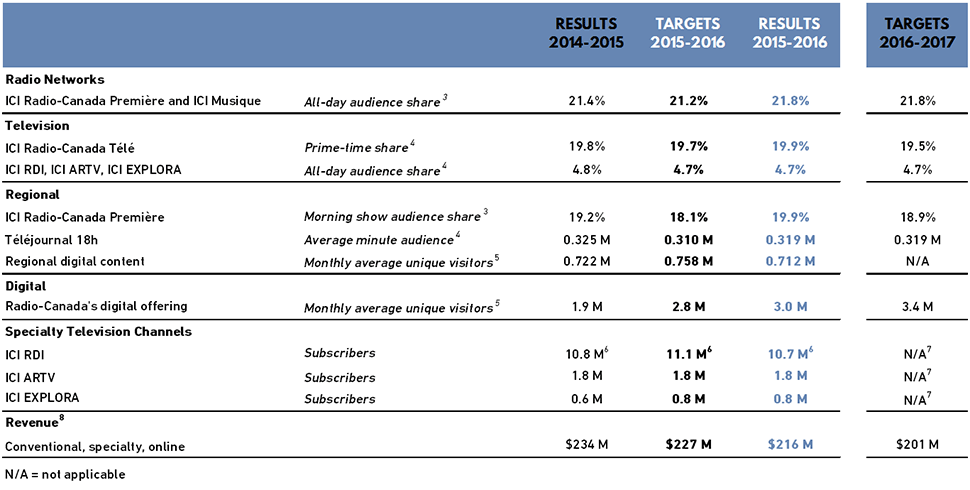CONTENT AND SERVICES
YEAR IN REVIEW
FRENCH SERVICES HIGHLIGHTS
In 2015-2016, Radio-Canada pursued the transformation that began two years ago in order to remain a leader and a creative powerhouse in the Canadian French-language media industry. The public broadcaster continued to deliver compelling original content that reflects the lives and experiences of all French-speaking Canadians, with the overriding commitment to meet their changing media habits.

The cast of Les pays d’en haut, ICI Radio‑Canada Télé
ACCELERATING OUR MULTIPLATFORM/MULTISCREEN STRATEGY
Radio-Canada is experimenting with non-standard broadcasting and distribution sequences for its properties – a strategy that produced positive results this year.
Part of this fundamental transformation involved accelerating the implementation of Radio-Canada’s multiplatform/multiscreen strategy, with original Canadian content continuing to be a priority. We launched a dozen new TV drama series and arts/variety shows this year, including Esprit critique, Le Clan and Le nouveau show. Furthermore, this visual content is now made more widely available on our many platforms (ICI Radio-Canada Télé, ICI ARTV, ICI EXPLORA, ICI Tou.tv), at the right time for our various target audiences. This year’s experiment with non-standard broadcasting/distribution sequences produced positive results. For example, the exclusive pre-release of the full second season of Série noire on ICI Tou.tv EXTRA in November had a significant impact on subscriptions and generated nearly 300,000 views.(1)
Radio-Canada’s multiplatform/multiscreen strategy also calls for a major digital shift, and we considerably expanded our original digital content offering in 2015-2016. Notable additions include five new original Quebec productions released in March 2016 on ICI Tou.tv (À ne pas faire à la maison, Barman, La vie n’est pas un magazine, L’écrivain public and Switch & Bitch); the new youth section introduced in June 2015; and the announcement of Véronique Cloutier’s channel, Véro.tv, for EXTRA subscribers starting in 2017. There was big news in Radio as ICI Radio-Canada Première launched Première PLUS in February 2016, the first 100%-free French-language on-demand radio streaming service, whose offering includes a number of original series (e.g. Brassard d’un soir, La route des 20 – Sur les traces d’une génération, Parce qu’on est en 2016). ICI Musique, for its part, organized music events that leveraged digital platforms and audience interaction, such as Le concert dont vous êtes le héros and Héros du piano.
Pursuing our News and Current Affairs Transformation
At a time when Canadians have access to an increasing number of news choices, Radio-Canada intends to remain the source of record.
To support its continuous news coverage, News and Current Affairs stepped up its production of digital formats targeting mobile platforms, and also released an updated Radio-Canada news app in late February 2016. There has been a strong response to the digital news offering. During the 2015 federal election, ICI Radio-Canada.ca received nearly 1.5 million visits – over twice the number recorded on election day 2011. Moreover, following the Paris attacks on November 13, 2015, a video uploaded by correspondent Jean-François Bélanger was viewed over 4.5 million times on the Téléjournal Facebook page.(1)
In the face of increasing choice in news, Radio-Canada intends to remain a reference, not only in terms of speed and accuracy, but also as the space for probing analysis that contributes to public debate and our country’s democratic life. As an example, Radio-Canada continued in 2015–2016 to develop multiplatform signature news events around issues of global importance, as witnessed in the special reports on the Paris Climate Change Conference and sugar as anemerging public health issue. The reach and impact of Radio-Canada’s News and Current Affairs coverage were also revealed once again through Enquête’s hard-hitting investigative report into alleged abuses by Sûreté du Québec officers of Aboriginal women and the documentary Omar Khadr: Out of the Shadows, co-produced with CBC. And, in March 2016, Radio Canada International (RCI) released a mobile app for the Eye on the Arctic website to promote circumpolar discussions in Canada and abroad.
Growing Deeper Roots in Regions
The teams’ motto, “More Local, More Often, on More Screens,” drove local digital initiatives this year.
Radio-Canada’s teams accelerated the multiplatform strategy and digital shift in the regions in 2015-2016. For instance, we rolled out new regional websites across the country with geolocated French-language content adapted to all screen sizes and mobile devices. News coverage on the web and through social networks was also expanded, and audiences responded very favourably. The ICI Radio-Canada.ca Regions section saw its visits (websites and mobile + apps) jump 37% between February 2015 and February 2016. Facebook accounted for 36% of visits in February 2016, up 13 percentage points over February 2015.(1) Also noteworthy is the regional multiplatform project Bienvenue chez les #NUMÉRICAINS, which relates how digital technology is changing the lives of French-speaking Canadians. It features a website, a series of 10 one-hour audio episodes, 31 audio and video testimonials, as well as over 50 personal stories submitted by social media users.
BRINGING FRENCH-SPEAKING CANADIANS TOGETHER
Radio-Canada remained a relevant, unifying force for all French-speaking Canadians.
In line with its mandate as Canada’s national public broadcaster, Radio-Canada remained a relevant, unifying force for all French-speaking Canadians. It continued once again this year to achieve success with its new prime-time shows on ICI Radio-Canada Télé, drawing average audiences of 1.6 million for Les pays d’en haut, close to 1 million for Ruptures and 0.9 million for Les dieux de la danse.(2) ICI Radio-Canada Télé’s Bye bye 2015 broke all previous audience records with an average of almost four million viewers on New Year’s Eve – an 88% audience share(2) – demonstrating once again how television has the power to bring Canadians together during special occasions. Also, as part of the 2016 Semaine des correspondants from January 4 to 8, foreign correspondents took Radio-Canada’s various platforms by storm to look back at the year’s top international stories, give their predictions for 2016 and answer questions from the audience.
French Services 2015-2016 RESULTS
The majority of Radio-Canada’s key performance indicators for radio, TV and digital met or exceeded the targets set for 2015-2016. As for financial indicators, self-generated revenue and ICI RDI’s subscriber levels fell short of expectations.
 |
- Radio – Includes the combined share of our two main radio networks - ICI Radio-Canada Première and ICI Musique - and the share for ICI Radio-Canada Première’s regional morning shows. The 21.8% fall 2015 combined share broke the prior year record of 21.7%.
- ICI Radio-Canada Télé – Highly competitive market, where our continued support of the conventional prime-time television schedule appears to be paying off. New successful shows (Les pays d’en haut, Ruptures, Les dieux de la danse), in addition to a strong multigenre line-up and high-profile returning programs (Unité 9, Mémoires vives, Tout le monde en parle). These audience successes are all the more critical since as we leverage our multiplatform/multiscreen strategy, we face the challenge of not sacrificing successes traditionally measured through TV audience share.
- ICI RDI, ICI ARTV, ICI EXPLORA – ICI RDI recorded high ratings, boosted by its continuous coverage of major news events (e.g., federal election, Paris attacks). ICI EXPLORA’s audience share increased during free preview periods throughout the year.
- Téléjournal 18h – After a slow start during fall 2015, the average minute audience (AMA) rose during the winter, a period that has seen higher viewer ratings historically.
- Digital – Canadians turned in large numbers to our regional, national and international digital content to make sense of key events and major breaking news stories (e.g. federal election, Paris and Brussels attacks, deaths of René Angélil and Jean Lapierre).
- Subscribers to Specialty Television Channels – Performance is subject to favourable factors (programming, promotional efforts) and structural challenges (consumption trends, regulatory environment).
- Revenue – Impact of the persistent softening of TV advertising market (3% decrease year-over-year in the Francophone market)(9) especially for conventional television.
Strategy 2020 performance metrics
 |
(1) Source: Adobe SiteCatalyst.
(2) Source: Numeris, Portable People Meter (PPM), Francophones in Quebec aged 2 years and older.
(3) Source: Numeris, fall 2015 survey (diary), Francophones aged 12 years and older. Morning show: Monday-Friday, 6:00-9:00 AM.
(4) Source: Numeris, Portable People Meter (PPM), Francophones in Quebec, aged 2 years and older. ICI Radio-Canada Télé: regular season; ICI RDI, ICI ARTV, ICI EXPLORA: April to March; Téléjournal 18h: regular season, Monday-Friday, 6:00-6:30 PM.
(5) Source: comScore Media Metrix, unique visitors aged 2 years and older, April to March. Prior to 2015-2016, the measure was desktop only. Starting in 2015-2016, the measure for Radio-Canada's digital offering is multiplatform, but desktop only for regional digital content. The comScore measurement basis for 2016-2017 regional digital content is being finalized and the target will be published once this is confirmed.
(6) In November 2014, one of our partners informed us of an error in the subscriber count for ICI RDI. The error had affected 2014-2015 annual results and was identified after we had set the annual target for 2015-2016. ICI RDI’s annual subscriber target for 2016-2017 is established in light of the now-known actual values.
(7) Target not finalized because of on-going negotiations with Broadcast Distribution Undertaking partners.
(8) Includes advertising revenue, subscription revenue and other revenue (e.g. content distribution). Revenue for ARTV is reported at 100%, even in 2014-2015although Radio-Canada owned only a 85% share prior to March 31, 2015. Since that date, Radio-Canada has been the sole owner of ARTV.
(9) Source : ThinkTV.
(10) Source: Mission Metrics Survey, TNS Canada. This is the per cent of Canadians who give us top marks (8, 9 or, 10 on a 10-point scale). The data are obtained from a high-quality telephone survey conducted among a representative sample of the Canadian population.
(11) Source: comScore, multiplatform measurement, monthly average unique visitors.
(12) Source: comScore, multiplatform measurement, monthly average visits.
(13) Source: Numeris, Time spent with our TV and Radio services; Adobe SiteCatalyst and comScore, Time spent with our Internet services.
